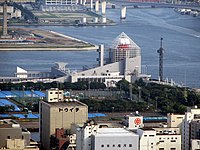Port of Tokyo
| Port of Tokyo | |
|---|---|

Harumi passenger terminal
|
|
| Location | |
| Country | Japan |
| Location | Tokyo |
| Details | |
| Owned by | Tokyo Port Authority |
| Type of harbor | Natural/Artificial |
| Size of harbor | 5,292 ha (52.92 sq km) |
| Land area | 1,033 ha (10.33 sq km) |
| Size | 6,325 ha (63.25 sq km) |
| Available berths | 205 |
| Employees | 30,000 (2007) |
| Statistics | |
| Vessel arrivals | 31,653 vessels (2008) |
| Annual cargo tonnage | 90,810,000 tonnes (2007) |
| Annual container volume | 3,696,000 TEU's (2007) |
| Value of cargo | ¥12,012.9 billion (2006) |
|
Website kouwan.metro.tokyo.jp/en |
|
The Port of Tokyo is one of the largest Japanese seaports and one of the largest seaports in the Pacific Ocean basin having an annual traffic capacity of around 100 million tonnes of cargo and 4,500,000 TEU's.
The port is also an important employer in the area having more than 30,000 employees that provide services to more than 32,000 ships every year.
The forerunner of the Port of Tokyo, the Edo Port (Edo Minato) played a very important role in the history of marine transport of Japan and as a distribution point for supplying goods for the people of Edo. During the Tokugawa Shogunate the Port of Tokyo was not allowed to open to international trade, although the neighbouring Port of Yokohama was already open for this kind of trade.
The development of the port was finally encouraged during the Meiji Period with the influence of a project that was meant to improve the estuary of the Sumida River by dredging channels and reclaiming land at Tsukishima and Shibaura.
The Kanto earthquake in 1923 served as a starting point of a full - scale terminal construction project, which was topped out with the opening of the first terminal Hinode in 1925. Alongside the completion of another two terminals, Shibaura and Takeshiba, the Port of Tokyo opened for international trade on May 20, 1941.
After World War II the development of the port became a vital task for the reconstruction of the Japanese industry, and construction started on the Toyosu coal terminal, the Harumi terminal and other terminals one after another.
By the late 1960s, the container transport system had become a major factor in shipping worldwide. In 1967, Nippon Container Terminals, Ltd. (NCT), became the port's (and Japan's) first container terminal operator. That same year, the first container ship to call on a Japanese port was the first such ship handled by NCT. This significantly contributed to establishing the Port of Tokyo as a major international trade port.
...
Wikipedia
